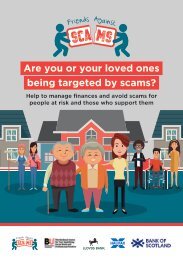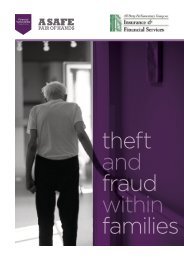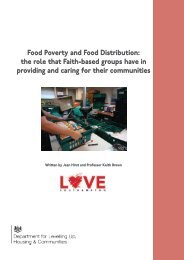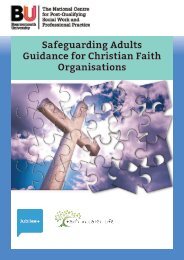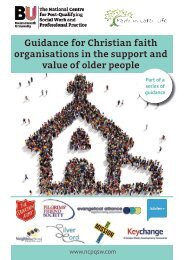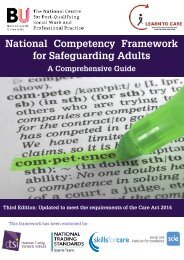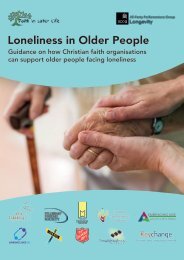0-Coercion and control report with pics FINAL
Coercion and control are used in both domestic and financial abuse. There are also differences in how agencies approach these concerns, and we seek to highlight this to learn from and utilise best practice.
Coercion and control are used in both domestic and financial abuse. There are also differences in how agencies approach these concerns, and we seek to highlight this to learn from and utilise best practice.
You also want an ePaper? Increase the reach of your titles
YUMPU automatically turns print PDFs into web optimized ePapers that Google loves.
The reason given for singling out this type of abuse for further explanation is ‘for the<br />
avoidance of doubt because some definitions of abuse may not ordinarily include this type<br />
of abuse’ (Care Act guidance 2014). This typifies the problem - financial abuse is often<br />
forgotten in the list of abuses despite its prevalence.<br />
In determining if someone meets eligibility criteria for a safeguarding response, we may<br />
need to ask ourselves challenging questions about our underst<strong>and</strong>ing of financial abuse <strong>and</strong><br />
the risk of it. Ash (2013) gives an example of a son regularly ‘borrowing’ his mother’s<br />
money <strong>with</strong>out repaying it. If she is dependent on him for care <strong>and</strong> support which in turns<br />
helps her stay in her own home (preventing the need for residential care) ‘does this routine<br />
appropriation of cash become less abusive? Might it be expedient for social workers to<br />
‘overlook’ a domestic situation which, if it collapsed, would present social services <strong>with</strong><br />
dilemmas about how best to support an elder <strong>with</strong> complex needs in a resource-starved<br />
service world?’ (Ash 2013:101).<br />
The Care Act 2014 guidance directly links safeguarding responsibilities <strong>with</strong> scam<br />
involvement ‘a scam, like any form of abuse, can be a one-off event or a longer-term<br />
interaction, resulting in chronic victimisation’ (SCIE, 2011; Fenge <strong>and</strong> Lee 2018:908).<br />
However, if a scamming victim does not appear to have a need for care <strong>and</strong> support <strong>and</strong> is<br />
living independently in their own home, what role does adult social care have here? Is<br />
being a victim of scamming enough to incite a response?<br />
Inherent in the Care Act 2014 are the duties to prevent the need for care <strong>and</strong> support <strong>and</strong><br />
to promote wellbeing. This means that local authorities should always have a person’s<br />
wellbeing in mind when making decisions <strong>and</strong> planning services, <strong>and</strong> must prevent needs<br />
from arising if they can. Financial abuse erodes people’s money <strong>and</strong> assets, <strong>and</strong> impacts<br />
heavily on mental health <strong>and</strong> independence. A person may not appear to need services at<br />
the point of the abuse taking place - so would not be eligible for a safeguarding response<br />
necessarily - but by the end of the abuse they are far more likely to need support. At which<br />
point therefore should we expect local authority involvement? ‘Within safeguarding<br />
practice, both a prevention focus <strong>and</strong> an early-intervention focus are imperative to enable<br />
the ability to respond as soon as possible in order to limit the exploitation of the older<br />
person’s finances <strong>and</strong>/or property’ (Phelan et al 2018:938).<br />
In our experience local authorities <strong>and</strong> care providers deal <strong>with</strong> high levels of unpaid care<br />
fees. If a family member is responsible for paying the fees (from the person’s own funds)<br />
but debts are occurring, it may be dealt <strong>with</strong> by a finance department initially - before<br />
being passed to the adult safeguarding service if debts continue. Our interest is in how long<br />
that process takes - <strong>and</strong> if is happening quickly enough to safeguard someone’s finances -<br />
<strong>and</strong> if instead of h<strong>and</strong>ing over, joint working should be the norm. Social care staff<br />
confidence in discussing finances is highlighted in existing research ‘the lack of training <strong>and</strong><br />
expertise in both asking the older person about finances <strong>and</strong> being able to decipher what<br />
could be FA (financial abuse’ was identified. This draws on a cultural reluctance <strong>and</strong> taboo<br />
to ask about private finances <strong>and</strong> this can be perceived as outside the remit of health <strong>and</strong><br />
social care service’ (Phelan et al 2018:936). In contrast, financial assessment teams may be<br />
19





